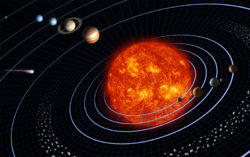"The theory of Milankovitch [also called Astronomical Theory] cycles states that periodic changes in Earth’s orbit cause increased summertime sun radiation in the northern hemisphere."[1] It is named after Milutin Milanković.
The Milankovitch theory is the main uniformitarian explanation for the dozens of Ice Ages that are alleged to have occurred over the last few million years. It is widely accepted due to a theory published 40 years ago as of December 2016, titled "Variations in the Earth's Orbit: Pacemaker of the Ice Ages."[2] The paper presents an argument based on two deep-sea cores from the Indian Ocean that the climate was undergoing cycles of roughly 100, 42, and 23 thousand years in length. It was seen as strong evidence for the paper that these numbers are very close to the cycle lengths that would be exhibited by the Earth's orbital and rotational motions in an ancient solar system.
Impact[edit]
The theory is of significant importance to Uniformitarian scientists because it is assumed in order to calculate the ages of seafloor sediment cores using a technique called "orbital tuning."[3] These seafloor sediment ages are then used to date the deep ice cores of Greenland, Antarctica, as well as other sediment cores. It is even used to calibrate argon-argon radioisotope dating.[4]
Connection to Climate Alarmism[edit]
Milankovitch theory also involves a very unstable climate for Earth, which has greatly contributed to climate alarmism. Atmospheric scientist Larry Vardiman notes: "If the basis for the Astronomical Theory is wrong, many of the more radical environmental efforts may be unjustified."[5]
Problems[edit]
Uniformitarian oceanographer Wolfgang Berger notes: "The agreement of dating by [basalt layers at the Brunhes-Matuyama boundary] and by Milankovitch tuning (urged by Shackleton et al. 1990) is the strongest argument yet for the correctness of Milankovitch theory."[6] However, the original Pacemaker paper used 1973 age estimates from a paper by Nicholas Shackleton and Neil Opdyke,[7] which assumed the most recent reversal of the Earth's magnetic field (Brunhes-Matuyama; B-M) occurred 700 thousand years ago, as obtained from potassium-argon dating. However, six years later, in 1979, uniformitarians revised the date to 730 thousand years ago.[8] The date was later revised again, based on orbitally tuned chemical wiggles in the Galápagos deep-sea core, to 780 thousand years.[9] Both ages cannot be true. When redone with the new estimates, the theory is no longer proven.[10][11]
References[edit]
- ↑ http://www.eurekalert.org/pub_releases/2007-09/uosc-cdd092507.php
- ↑ Hays, J.D., J. Imbrie, and N.J. Shackleton. 1976. Variations in the Earth's Orbit: Pacemaker of the Ice Ages. Science. 194 (4270): 1121-1132.
- ↑ Herbert, J. 2014. Ice Cores, Seafloor Sediments, and the Age of the Earth, Part 1. Acts & Facts. 43 (6): 12-14
- ↑ Renne, P. R. et al. 1994. Intercalibration of astronomical and radioisotope time. Geology. 22 (9): 783-786
- ↑ Vardiman, L. 2001. Climates Before and After the Genesis Flood. El Cajon, CA: Institute for Creation Research, 79.
- ↑ Berger, W. H. 2014. On the Beginnings of Palaeoceanography: Foraminifera, Pioneers, and the Albatross Expedition. In Landmarks in Foraminiferal Micropalaeontology: History and Development. A. J. Bowden, F. J. Gregory, and A.S. Henderson, eds. London: Geological Society Publishing House: 169.
- ↑ Shackleton, N.J. and N. D. Opdyke. 1973. Oxygen Isotope and Palaeomagnetic Stratigraphy of Equatorial Pacific Core V28-238: Oxygen Isotope Temperatures and Ice Volumes on a 10[to the fifth power] Year and 10[to the sixth power] Scale. Quaternary Research. 3 (1): 39-55
- ↑ Mankinen, E. A. and G. B. Dalrymple. 1979. Revised Geomagnetic Polarity Time Scale for the Interval 0-5 m.y. B.P. Journal of Geophysical Research: Solid Earth. 84 (B2): 615-626
- ↑ Spell, T.L. and I. McDougall. 1992. Revisions to the age of the Brunhes-Matuyama Boundary and the Pleistocene geomagnetic polarity timescale. Geophysical Research Letters. 19 (12): 1181-1184
- ↑ Hebert, J. 2016. Milankovitch Meltdown, Part 2. Acts & Facts. 45 (12): 10-13.
- ↑ All sources are as quoted from Hebert, J. January, 2017. Milankovitch Meltdown, Part 3. Acts & Facts. pp. 10-13
